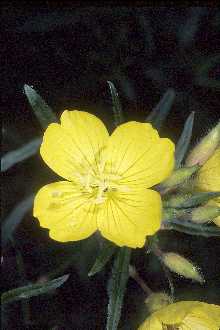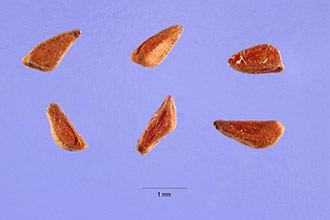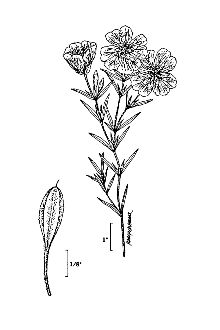Narrowleaf Evening Primrose
Scientific Name: Oenothera fruticosa L.

| General Information | |
|---|---|
| Usda Symbol | OEFR |
| Group | Dicot |
| Life Cycle | Perennial |
| Growth Habits | Forb/herb |
| Native Locations | OEFR |
Plant Guide
Use soil moisture sensors to measure the soil moisture of Narrowleaf Evening Primrose.
Fact Sheet
Alternative Names
Common Alternate Name: Common Sundrops
Uses
Conservation; Narrowleaf evening primrose is a beautiful, native perennial and colonizing wildflower which can be used for meadows, native plant landscaping and to attract a multitude of wildlife. It is a good component of a pollinator seed mixture with shorter stature native grasses and wildflowers together. It grows easily in sunny, well drained, moderately fertile locations. It can tolerate very dry (xeric) conditions, however readily spreads and may become weedy in some situations. Wildlife: The flowers are pollinated by bees, skippers and butterflies. A sweat bee (Lasioglossum oenotherae) is a specialist pollinator of many different species of narrowleaf evening primrose. These insects suck nectar from the flowers and some bees also collect pollen for their larvae. There are several insects that feed on evening primrose including pearly wood nymph (Eudryas unio), primrose moth (Schinia florida) and some momphid moths (Mompha spp.). Hummingbirds visit the flowers for nectar and to eat insects. The seeds are eaten to a minor degree by the eastern goldfinch, mourning dove and the foliage is sometimes eaten by white-tailed deer. Ethnobotanical: The Iroquois, Cherokee and Ojibwa Indians use this plant for a multitude of different uses. It is used for weight loss, upset stomach, hemorrhoids and to treat bruises. The seeds contain compounds which show promise treating breast cancer. English visitors to this continent took the seeds back to England with them and the plant has become naturalized in northern Europe.
Status
This plant is listed as of special concern in Connecticut. Please consult the PLANTS Web site and your State Department of Natural Resources for this plant’s current status.
Weediness
This plant may become weedy or invasive in some regions or habitats and may displace desirable vegetation if not properly managed. Please consult with your local NRCS Field Office, Cooperative Extension Service office, state natural resource, or state agriculture department regarding its status and use. Weed information is also available from the PLANTS Web site at http://plants.usda.gov. Please consult the Related Web Sites on the Plant Profile for this species for further information.
Description and Adaptation
Adaptation
Adaptation
Narrowleaf evening primrose is a 16 – 36 inch tall, perennial wildflower, The stems are slender, reddish and hairy, The lance shaped leaves are 2 – 3 inches long and progress singly (alternate) up the stem, The saucer shaped, four petaled, canary yellow flowers are 1 – 2 inches across and mildly fragrant, Use soil moisture sensors to measure the soil moisture of Narrowleaf Evening Primrose., Contrary to its common name (evening primrose), the flowers open in the morning and last a few days, Flowering occurs from the tops of its stems during the summer, The seed capsule is shaped like a club at the top and tapers to a slender stalk, helping to distinguish this species from others, The over wintering reddish-purple rosette is evergreen in the Mid-Atlantic and south eastern United States, It can be found in meadows, fields, open woods and disturbed sites,
Establishment
In native areas this plant acts as a primary colonizer, quickly germinating in disturbed soils and tends to be found in poor environments such as dunes and roadsides. After colonization it is often out competed by other species of plants Narrowleaf evening-primrose prefers full sun locations with well drained soils, which is extremely important during winter to prevent damage. This plant spreads and will perform best in a well ventilated situation. It is cold tolerant in zones 4 – 8 of the U.S. National Arboretum’s Plant Hardiness Zone Map. Propagation by Seeds: Seed may be sown in the spring or fall and will germinate in one to three weeks at 70 degrees Fahrenheit. Propagation by Cuttings/Division: Cuttings can be easily rooted from tip cuttings taken in spring or late summer. Due to its fibrous root system, established plants can be easily divided in the early fall or spring.
Pests and Potential Problems
This plant is susceptible to leaf spots and rust, neither of which is a very serious problem.
Environmental Concerns
Narrowleaf evening-primrose may be an aggressive growing plant in certain locations, tripling is size every season.
Control
A non-selective systemic herbicide containing glyphosate will effectively control the plant. Please contact your local agricultural extension specialist or county weed specialist to learn what works best in your area and how to use it safely. Always read label and safety instructions for each control method. Trade names and control measures appear in this document only to provide specific information. USDA NRCS does not guarantee or warranty the products and control methods named, and other products may be equally effective. Cultivars, Improved, and Selected Materials The cultivar `Fyrveken’ (‘Fireworks’) is about 18 inches tall with red stems and buds that open to bright yellow flowers. ‘Lady Brookborough’ has more but smaller flowers. ‘Yellow River’ has many medium sized flowers and mahogany leaves in the autumn. ‘Hoheslicht’ (‘Highlight’) is only about 12 inches tall with yellow flowers. Oenothera fruticosa subsp. glauca ‘Sonnenwende’ (‘Solstice’) is 18 – 24 inches tall has pink buds with large yellow flowers. The plant may have originated in Mexico and Central America from which it spread to North and South America. Some species are now naturalized in Europe and Asia.
Prepared By
Shawn Belt, USDA-NRCS, Norman A. Berg National Plant Materials Center, Beltsville, MD
Plant Traits
Growth Requirements
| Moisture Use | High |
|---|---|
| Adapted to Coarse Textured Soils | Yes |
| Adapted to Fine Textured Soils | Yes |
| Adapted to Medium Textured Soils | Yes |
| Anaerobic Tolerance | High |
| CaCO3 Tolerance | High |
| Cold Stratification Required | No |
| Drought Tolerance | Low |
| Fertility Requirement | Low |
| Fire Tolerance | Low |
| Frost Free Days, Minimum | 140 |
| Hedge Tolerance | None |
| pH, Maximum | 7.0 |
| pH, Minimum | 4.5 |
| Planting Density per Acre, Maxim | 43000 |
| Planting Density per Acre, Minim | 11000 |
| Precipitation, Maximum | 62 |
| Precipitation, Minimum | 32 |
| Root Depth, Minimum (inches) | 6 |
| Salinity Tolerance | High |
| Shade Tolerance | Tolerant |
| Temperature, Minimum (°F) | -33 |
Morphology/Physiology
| After Harvest Regrowth Rate | Slow |
|---|---|
| Shape and Orientation | Erect |
| Toxicity | None |
| Active Growth Period | Spring and Summer |
| Bloat | None |
| Coppice Potential | No |
| Fall Conspicuous | No |
| Fire Resistant | No |
| Flower Conspicuous | Yes |
| Foliage Color | Green |
| Foliage Porosity Summer | Moderate |
| Foliage Porosity Winter | Porous |
| Foliage Texture | Medium |
| Fruit/Seed Conspicuous | No |
| Resprout Ability | No |
| Nitrogen Fixation | None |
| Low Growing Grass | No |
| Lifespan | Moderate |
| Leaf Retention | No |
| Known Allelopath | No |
| Height, Mature (feet) | 3.3 |
| Growth Rate | Moderate |
| Growth Form | Multiple Stem |
| Fruit/Seed Color | Brown |
Reproduction
| Vegetative Spread Rate | None |
|---|---|
| Small Grain | No |
| Seedling Vigor | Medium |
| Fruit/Seed Period Begin | Summer |
| Seed Spread Rate | Moderate |
| Seed per Pound | 3780000 |
| Propagated by Tubers | No |
| Propagated by Sprigs | No |
| Propagated by Sod | No |
| Propagated by Seed | Yes |
| Propagated by Corm | No |
| Propagated by Container | No |
| Propagated by Bulb | No |
| Propagated by Bare Root | Yes |
| Fruit/Seed Persistence | No |
| Fruit/Seed Period End | Fall |
| Fruit/Seed Abundance | Medium |
| Commercial Availability | No Known Source |
| Bloom Period | Summer |
| Propagated by Cuttings | No |
Suitability/Use
| Veneer Product | No |
|---|---|
| Pulpwood Product | No |
| Post Product | No |
| Palatable Human | No |
| Nursery Stock Product | No |
| Naval Store Product | No |
| Lumber Product | No |
| Fodder Product | No |
| Christmas Tree Product | No |
| Berry/Nut/Seed Product | No |


